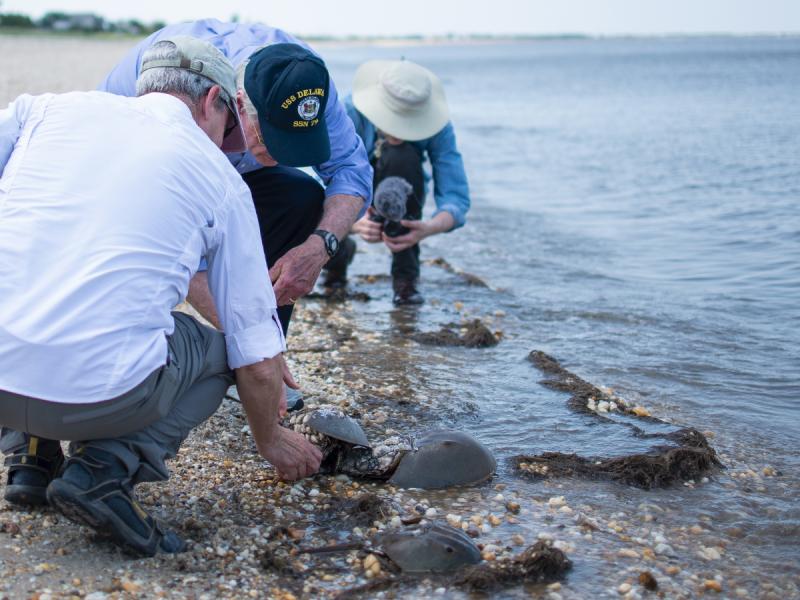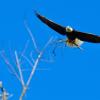Sen. Tom Carper joined Slaughter Beach Mayor Harry Ward to engage in the Just Flip 'Em program that focuses on the health and survival of horseshoe crabs along the coast.
The Just Flip 'Em program has gained global attention with this occurring around the world due to it's positive impact, not only on the survival of horseshoe crabs but the shorebirds that feast on horseshoe crab eggs during their migratory path north during colder weather.
Groups of volunteers and community members walk the beach every day and flip over horseshoe crabs that had been turned over due to the tide, and place those that are too far from the water in a better position to return successfully into the Delaware Bay.
Since that Slaughter Beach and surrounding areas are spawning hot spots, and contain the highest concentration of this particular species of crab in the world, it has become vital to organizations as well as the community to take part in helping maintain the population.
Carper joined Ward as they strolled down the beach in deep conversation about the positive impact this has had on coastal biodiversity. Upon finding two horseshoe crabs far from the water, Carper and Ward did not hesitate to pick them both up and make their way to the water's edge.
Ecological Research & Development Group President Glenn Gauvry was also on hand, and showed the senator the various parts of the crab and how to distinguish males from females, etc.
"We started this program in 1998, and have since seen a growing compassion and interaction of community members and volunteers with the population of horseshoe crabs that are part of our unique natural habitats along the coast. This is now an international organization that focuses on saving lives, and the positive engagement of people and the species that are essentially neighbors to us," said Gauvry.
Carper gently placed the two horseshoe crabs a few inches from the edge of the tide, allowing them to feel the water, and make their way into the Delaware Bay.
"I am certainly no stranger to horseshoe crabs, being that they are such a large part and contributor to our diverse ecosystem in Delaware," said Carper. "Programs like this, and the involvement of nonprofit organizations and community members truly make such a positive impact on the health of one of the most unique yet fragile collections of beaches that Delaware has to offer."
Slaughter Beach is the epicenter of spawning for horseshoe crabs along the bay coast, and based on lunar events and the weather, there could be up to 1,000 crabs on the beach at high tide. Action has been seen the most in areas that are developed or have homes on the beach, so focusing on areas with no development or homes is one of the things that Gauvry finds important. To combat this problem, DNREC approved a barrier fence at neighboring Pickering Beach that helps to keep horseshoe crabs from venturing too far from the water, and it has been a great success thus far.
Dr. Carol Meteyer, a Slaughter Beach resident and forensic veterinarian, conducted a study of the health of horseshoe crabs during the week of May 24-29. This study is a joint effort between The National Aquarium, Johns Hopkins, the Joint Pathology Center, Ecological Research & Development Group and UD Lewes. The team will examine horseshoe crabs that have flipped and are stranded on the beach for evidence of poor health and disease.
"Getting a better understanding of health problems, the effects of heat and the protective microbiome that helps the survival of horseshoe crab eggs will give us more in-depth information on how we can continue to help in any way that we can," said Meteyer.
Community members such as 25-year resident and advisory council member Bill McSpadden continue to be a part of various projects focusing on the environment. "Our goal is to not only make a difference, but educate the public, specifically children, to help engage them in issues that surround various species and locations along our coast. The ecological significance of education is key, as small changes make such a huge difference," he said.
"Programs like this are helpful for our community and organizations to gain exposure due to their continued commitment to environmental issues. Our community is very aware and knowledgeable about issues that we face but they are here for a reason, to help. With 98 percent of Slaughter Beach being preserved land, it is about coexisting with the species that grace our beautiful land, air and water as well as the array of plant life we see around us," said Ward.
For information on the ERDG, go to horseshoecrab.org.
Dr. Cathy Meteyer can also be contacted by email at hschealthstudy@gmail.com.






















































